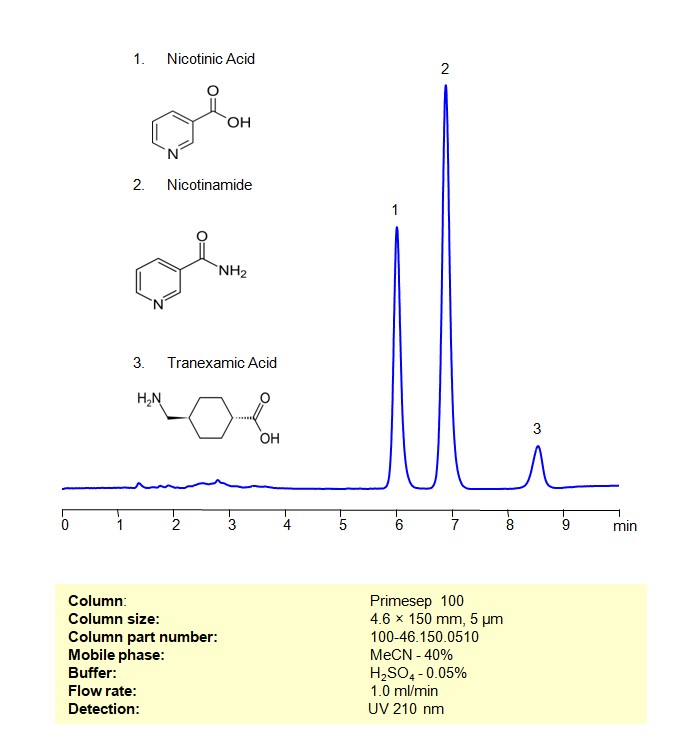HPLC Method for Separation of Nicotinic Acid, Nicotinamide, Tranexamic Acid on Primesep 100 Column
Separation type: Liquid Chromatography Mixed-mode SIELC Technologies

High Performance Liquid Chromatography (HPLC) Method for Analysis of Nicotinic Acid/Niacin (3-pyridinecarboxylic acid), Nicotinamide, Tranexamic acid
Nicotinic acid and nicotinamide are both forms of vitamin B3, also known as niacin. They play crucial roles in the body’s energy metabolism and are essential for maintaining the health of the skin, nervous system, and digestive system.
- Nicotinic Acid (Niacin): This is one of the two principal forms of vitamin B3. Nicotinic acid is commonly used as a dietary supplement to treat vitamin B3 deficiency, and it’s also prescribed in higher doses to help lower cholesterol levels. It works by dilating blood vessels, which can lead to a flushing sensation, hence it is sometimes referred to as “flushing niacin.”
- Nicotinamide: Also known as niacinamide, this is the other principal form of vitamin B3. Nicotinamide is a precursor to nicotinamide adenine dinucleotide (NAD+), a coenzyme involved in various cellular processes, including energy metabolism. Nicotinamide is often used in skincare products for its anti-inflammatory properties and its ability to improve the appearance of aging skin and reduce hyperpigmentation.
Tranexamic acid, on the other hand, is a synthetic derivative of the amino acid lysine. It is primarily used as an antifibrinolytic agent, meaning it helps to prevent the breakdown of blood clots. Tranexamic acid is commonly used to treat or prevent excessive bleeding, particularly in conditions such as heavy menstrual bleeding, traumatic hemorrhage, and during surgeries where significant blood loss is expected. Additionally, it has been investigated for its potential role in treating melasma, a common skin condition characterized by hyperpigmentation.
Each of these compounds has distinct biochemical properties and medical applications, but they all play important roles in human health and medicine.
Nicotinic Acid, Nicotinamide, Tranexamic Acid can be retained and separated using a Primesep 100 mixed-mode stationary phase column. The analysis employs an isocratic method with a simple mobile phase comprising water, acetonitrile (MeCN), and sulfuric acid as a buffer. This method allows for detection using UV at 210 nm
| Column | Primesep 100, 4.6 x 150 mm, 5 µm, 100 A, dual ended |
| Mobile Phase | MeCN 40% |
| Buffer | H2SO4 – 0.05% |
| Flow Rate | 1.0 ml/min |
| Detection | UV 210nm |
| Class of Compounds | Acids |
| Analyzing Compounds | Nicotinic Acid/Niacin (3-pyridinecarboxylic acid), Nicotinamide, Tranexamic acid |
Application Column
Primesep 100
Column Diameter: 4.6 mm
Column Length: 150 mm
Particle Size: 5 µm
Pore Size: 100 A
Column options: dual ended
Nicotinic Acid/Niacin (3-pyridinecarboxylic acid)
Tranexamic acid





